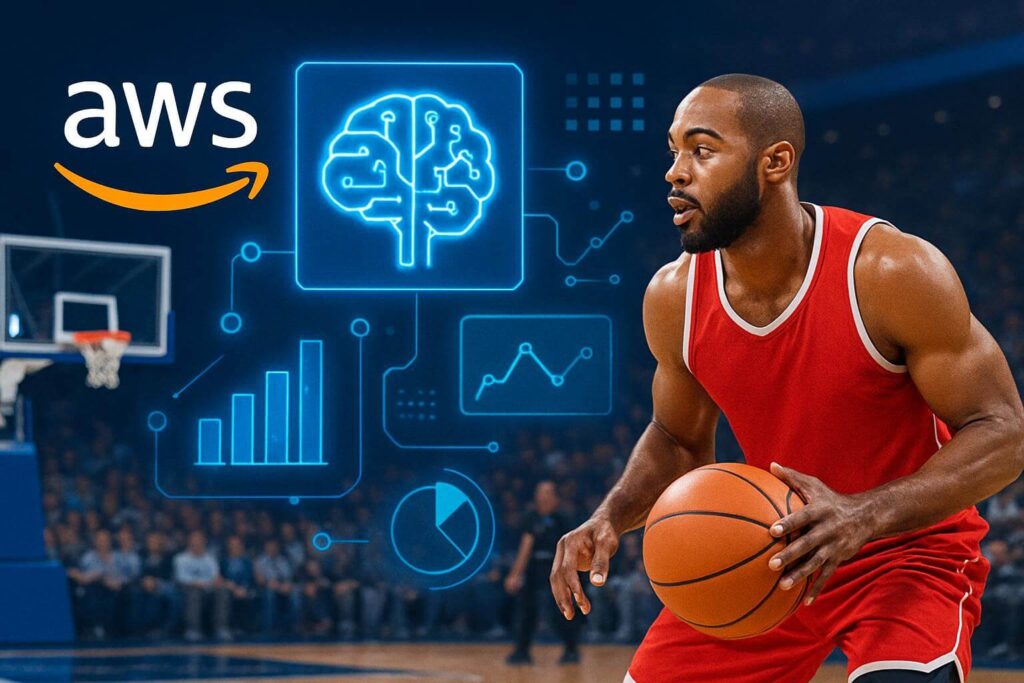
A Smarter Way to Track the Game
The NBA has partnered with AWS to push statistics into the future. For years, box scores gave fans the basics—points, rebounds, assists. Then came advanced metrics like player efficiency rating and true shooting percentage. But now, the league introduces something more ambitious. With AWS AI, fans can check NBA stats in real time with layers of detail never seen before. It feels less like a box score and more like stepping inside the game itself.
What AWS AI Brings to NBA Stats
At the core, AWS AI maps 29 points of every player’s body during a match. It tracks movement, spacing, and difficulty of plays. A simple layup might get labeled as a high-probability attempt. A contested jumper could reveal how slim the odds really were. Broadcasters will add these AI-driven stats into live coverage.
This goes far beyond box scores. Fans will see new terms like “gravity”—a measure of how defenders react to a star’s presence. Shot difficulty will no longer be just a guess. Defensive impact will become visible, even when it doesn’t appear in a stat line.
Pros: Why Fans Will Love It
The biggest advantage is clarity. Fans get context behind the numbers. Scoring 30 points may look impressive, but AWS AI can show whether those points came from smart plays or risky shots. Another pro is accessibility. This data won’t stay hidden in team laptops—it appears on screens for everyone.
It also changes debates. Fantasy players, analysts, and casual fans can argue with better evidence. The eye test meets AI verification. For coaches and teams, the system offers instant insight. Adjustments can happen mid-game based on data that once took days to process.
Cons and Risks of AWS AI in the NBA
Yet, the rise of AI-driven stats has downsides. The biggest risk is over-reliance. Numbers may overshadow the emotional rhythm of basketball. Heart, leadership, and instinct rarely show up in metrics. Critics argue that too much focus on AI may reduce the game to formulas.
Another issue is complexity. Fans who love the simplicity of points and assists might feel lost with terms like gravity scores or shot probability. Broadcasters must balance storytelling with data overload.
There’s also the question of fairness. If betting markets adopt AWS AI insights, sharp players may gain an edge while casual fans fall behind. Teams could also use the system unevenly, giving wealthier organizations more advantage.
The Future of NBA Stats with AWS AI
Even with risks, the NBA sees AWS AI as a future cornerstone. The technology could one day predict fatigue levels, injury risks, or even suggest the best possible play. Virtual reality replays might allow fans to view a possession through AI analysis, seeing the game as if they were the player.
But the real twist lies in balance. AI gives incredible power, but the game still thrives on human magic. A clutch three-pointer will always bring fans to their feet. A dunk will always send shockwaves through the arena. No algorithm can measure adrenaline or passion.
What AI does is add another layer. It helps us understand why a shot worked or why a defense collapsed. It tells us the hidden story behind the highlight.
Final Verdict on AWS AI in NBA Stats
AWS AI in the NBA is a bold experiment that blends sport with science. The pros are obvious—deeper insight, fairer analysis, and richer fan debates. The cons are real—risk of data overload and detachment from the game’s human side. But history shows innovation usually sticks. The shot clock and three-point line once felt strange. Now, they define basketball.
So, the verdict is simple. Fans should embrace this new way to check NBA stats with AWS AI. It won’t replace passion, but it will sharpen understanding. Basketball has always been a game of numbers. Now, those numbers just got smarter.






